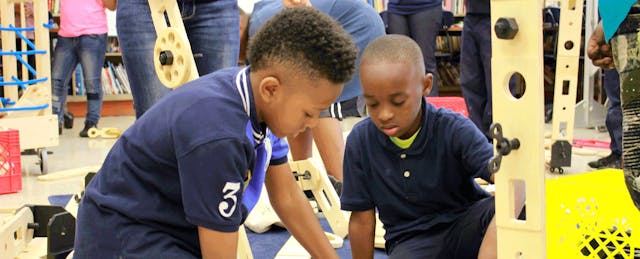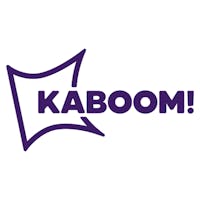Tools are powerful. Pedagogy is powerful. When combined appropriately, they are transformative.
First grade teacher Byron Gilliland has combined Rigamajig (the right tool) with Deeper Learning (the right pedagogy) to facilitate a learning environment that sees all students embrace their curiosity, creativity, critical thinking and collaborative abilities to own their learning at a higher level.
EdSurge: How did you first hear about Rigamajig? What convinced you to start using it?
Gilliland: I first learned of Rigamajig from my wife—an early childhood educator who noticed it on Twitter. I was looking for grant opportunities to do something creative and it seemed that Rigamajig was a good fit. I put in a grant for a set through Fastenal. I received the grant and got my first set. As soon as I saw them, my hamster wheels started turning. These were perfect for me, as I like to build, modify and tinker, and so do my students.
How did you get buy-in from administrators to use it?
Initially, it was because there were no funding barriers with the grant supporting them. But once people saw them in action, it was easy to get them excited. We did a STEM Expo Night and we incorporated Rigamajig. The whole school community—students, staff, parents and families—saw our students create and tinker with Rigamajig. And then we started using them successfully in our core content areas. If my administrator asks me how to demonstrate how Rigamajig improves or helps learning, I’m always ready to share and explain. I ask my students to do this as well. It's about problem solving, and it gets people excited.
Have you always been interested in hands-on learning? Why do you think it’s so important?
Yes, I’ve always been interested in seeing my students engaged, curious and creative. But the ultimate for me is to see how students with learning or social-emotional challenges respond to opportunities to engage with activities that include tools like Rigamajig. Rigamajig gets everyone—even those often disengaged or reluctant learners—connected to the class and learning. First grade is a great time to get all learners engaged and transition into more deeper learning. If a student needs a break or is having a tough time, Rigamajig works well to calm them.
Walk us through an average day using Rigamajig—How are you using them? In what settings?
In the beginning, they used them more during the tinker time or exploration. Then, we began to use them a lot to develop literacy. This includes, but is not limited to using them during reading time as site words, using them as sentence starters, using them as manipulatives to create words and advance their vocabulary, as well as using them in a readers’ theatre for creating spaces and characters. In science, we use them for design, testing and problem solving. In math, we use them for graphing, adding parts and even math facts. Students even enjoy increasing their organizational skills with these during clean up time.

How big is the difference in teaching concepts with Rigamajig as without? Any specific examples?
We use them to address problems and challenges that we encounter in our real world. One year, students proposed the idea of addressing the fact that we had students in our community that didn’t have access to books at home. They used Rigamajig to design and build a Lending Library. Staff and the community donated the books and the Rigamajig was used to house the books in front of the school. They can create prototypes, incorporate them into presentations, and ultimately have more voice and choice opportunities. These are great for project-based learning and deeper learning.
What do you like most about Rigamajig?
The collaboration and teamwork while using Rigamajig is amazing. Sometimes, I just stand back and listen to the students’ conversations and their questions. It’s really fun to observe and see how they problem solve in real time. Rigamajig has endless possibilities. Each year, students continue to figure out new applications for Rigamajig. It’s reciprocal teaching between teachers and students. Nothing will get a first grader more excited than sharing and presenting projects that they have created with Rigamajig.
This year, our spaces are different with social distancing requirements due to the pandemic. So, we used Rigamajigs to create the entryway to our classroom. We also regularly use these outside. I find that these are great ways to create the outdoor and play-based learning environments.
How does hands-on learning help you connect STEM or STEAM concepts for your students?
I always say that I want to make my classroom as fun as possible. But beyond that, I am committed to preparing my students for the real world. Rigamajig—along with the projects we do using them—do that. They learn powerful, foundational skills and concepts. These include critical thinking, problem solving, creativity, collaboration and the fortitude to push through. This is crucial to their future. Additionally, educators sometimes say they are challenged to get female students involved in STEM or STEAM. But in my classroom, there is no difference. Using things like Rigamajig for the challenges we create, there are no delineations. All of my learners are all engaged. They have different interests and ideas, but they all find a way to create meaningful learning. No one gets left out here. They learn from each other.
Do you think your success with Rigamajig is repeatable? What do you think a school needs in order to have the success that you did?
First, we all need a network of like-minded educators to collaborate with and bounce ideas off of for sure. These things can often take some time to get the engine rolling. But once you do, look out. I recommend allowing students to figure out ways to use Rigamajig and then teach the teachers. Turn the students loose and pay attention to how they can be used. I have a lot of faith in students that they can help us figure out ways to keep using Rigamajig in new and powerful ways. My students will come up with ways to use them in new ways, especially in our ever-changing learning environments. It’s an amazing tool and we have to have the pedagogy to maximize. There are so many applications. Make them a part of your classroom and they will provide ways to be useful and meaningful.

From your personal perspective and observations, please speak to the impact Rigamajig has had on your students’ interest and awareness of STEM/STEAM subjects and/or careers.
It’s human nature to often solve problems the way we’ve solved them before. But these provide us a way to see problems and their potential solutions differently. It’s powerful to watch students create new ideas and then watch how they share them, pitch them, present them and even collaborate on them. This is a glimpse of what they will do going forward. If our entire world, including the adult world, operated like students do when using things like Rigamajig and being engaged in STEM, we’d be better off.
It creates curiosity. If I can get a student curious, then we can do so many things. Curiosity is motivating for students, but should be for teachers as well. It’s easier to sometimes give answers in the short-term, but it’s not what we need in the long-term. This way is much more powerful.



